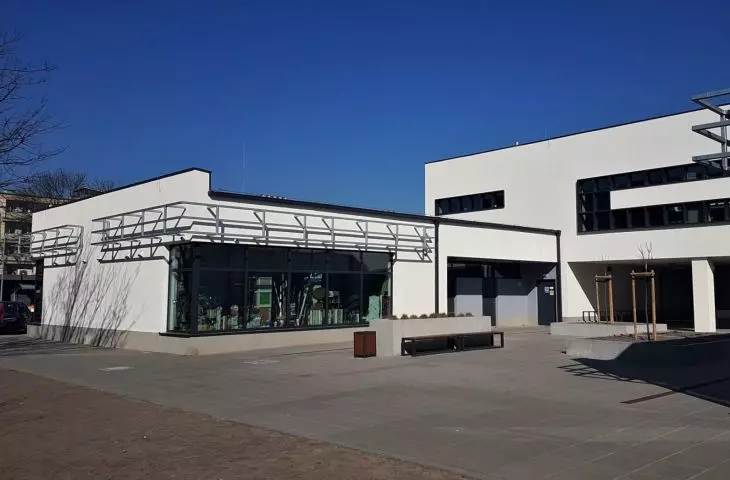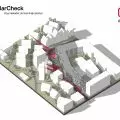A right idea, but poor execution. A modernist commercial and retail complex from half a century ago was recreated in Poznań's Grunwald district. However, the successful and timeless project was implemented very sloppily: both from the functional and execution side. Together with the marketplace, which has been modernized in recent years, it does not form a coherent, well-thought-out whole and perpetuates the mistakes from before the reconstruction.
The pavilions that have just been reconstructed were built in the late 1960s, designed by Bogdan Celichowski, Wojciech Kasprzycki and Włodzimierz Wojciechowski (1970s appearance available here). They served as a commercial and retail center for the first modernist residential district of Grunwald in postwar Poznań . The simple, disjointed body was composed of six one-story cuboid buildings. Above four of them was located the volume of the second floor with an external staircase accessible from a patio forming part of a passage running through the center of the establishment. At its outlet there was still to be a district cinema, which, however, was not realized. In recent decades, a marketplace was built between the pavilions and Grochowska Street .
competition without realization
At the beginning of this century, the pavilions and the chaotic market were in urgent need of renovation and revaluation (the state before the renovation can be viewed: here) In 2015, the city held a closed competition for the transformation of the entire premise. Six studios were invited to participate, and consulted their ideas with residents and merchants. The winner was the Decone office, which proposed leaving the renovated pavilions and creating a covered marketplace in a form reminiscent of a modernist commercial center. The design culturally respected the original premise and offered the hope of producing a high-quality neighborhood center. Unfortunately, things turned out differently. There was not enough money for implementation and the quarter's renovation was carried out in two stages.
First, a new marketplace was built, which, however, is far from the class of the competition design. In several rows with narrow passageways, rather cramped, not very aesthetically pleasing steel stalls and several pavilions were erected. They were set up without any connection to the modernist complex and surroundings. No passageways were created between the stalls in the axis of the clearances of the shopping complex and neighboring blocks. An unfavorable traffic layout was perpetuated, with an alley and parking lot separating the market from the pavilions. In addition, merchants complain about the non-functionality of the stalls. Many of them stand empty, while operating ones are overloaded with goods.
Reconstructed shopping pavilions and marketplace on Świt Street in Poznań
photo: Jakub Głaz
Finally, in 2019, a major renovation of the pavilions began. However, it turned out that they were in bad condition and had to be demolished The investor: the Board of Communal Housing Resources, decided to rebuild the complex in a form as close to the original as possible - with improvements to raise the standard of use (including air conditioning). The long-drawn-out investment was completed in January this year. The result is disappointing. Only from afar does the whole complex look decent, almost like in photographs from the early years.
clumsy copy
Reconstructed shopping pavilions on Świt Street in Poznań - a walkway within the complex
photo: Jakub Głaz
Close contact, however, strips away any illusions. The complex is surrounded, as before the renovation, by parking spaces. Cars pull up in front of the storefronts, they even stand in the axis of the main passage and cross passages leading to the housing development and towards the market square. It's also hard to understand why the newly built building has been disfigured with sizable ventilation installations on the roof of the second floor. Also strange is the location of the riser with an elevator (there was none before), which - instead of being located within the block - stood in the passage leading to the patio. After all, building almost from scratch, it was possible to skillfully hide these new elements. There was also a lack of attention to detail - significant for the modernist form, e.g. narrow muntins were replaced by wider elements, and the area of glazing previously reaching up to the roof was reduced. As early as last autumn, Wojciech Krawczuk, president of the Poznan SARP, rightly criticized the ending investment in the pages of Gazeta Wyborcza:
What is there now is a clumsy copy. Knowing that the original modernist fabric is only suitable for demolition, perhaps it should have been designed from scratch after all.
Finally, the workmanship and supervision of the project have failed. The entire project is extremely sloppily executed. The concrete landscaping elements are not only of poor quality, but also chipped, crooked or poorly attached. There could also have been more space for greenery and more mature trees planted within the walkway. There are also problems with accessibility for people with disabilities: there are steps between the sidewalk and the entrances to the pavilions!
Rebuilt commercial pavilions on Świt Street in Poznań - outdoor patio stairs
Photo: Jakub Głaz
stairs to be fixed
The biggest scandal, however, is the stairs within the patio. The raw concrete used to make them is crumbling and looks substandard. It lacks almost everything to the high quality of architectural concrete. The details of the balustrade and the solution of its contact with the wall are associated with haphazard "economic" workmanship typical of many private developments from the communist era. Apparently reconstructing modernist forms, it was also decided to repeat the sloppy workmanship typical of the previous era. However, there is no return to the interesting neon signs that once adorned the space above the windows. Yes, there are racks for their installation, but not a single neon sign, the form of which had already been worked out together with residents, has appeared so far. Instead, one can already see haphazard signs and cards stuck on the windows of already rented pavilions. The facility thus lacks decent management from the very beginning.
The case of Poznan's district center shows that even a reasonably faithful reproduction of a successful modernist form does not guarantee success. What was missing was a coherent concept and thinking about the functioning of the whole within the neighboring development enriched in recent years by a high-class residential building designed by one of Poznań's best studios Insomia Szymon Januszewski. The contrast between the ingenuity of this project (characteristic conservatories on balconies) and the high quality of its execution is striking.






































































